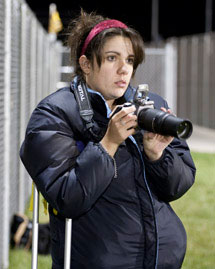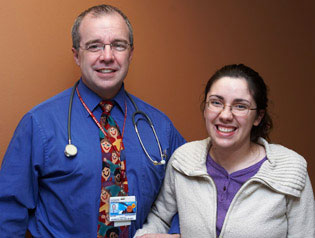Cathryn King
Cathryn King Has Come a Long Way

“Porphyria has been described as one of those things you learn about in medical school but don’t expect to see in your hospital. Then there she was,” said Alma Bicknese, M.D.
Cathryn King, then 16 years old, came to SSM Cardinal Glennon Children’s Medical Center on June 28, 2005. She had undergone weeks of evaluation and therapy for abdominal pain, and even surgery to remove her gall bladder before coming to St. Louis. But her condition had continued to worsen and her disease defied diagnosis.
“My muscles kept getting weaker and they couldn’t figure out what was wrong,” she said.
When she reached Glennon she was barely able to walk due to muscle weakness. Over the next week, she gradually lost the ability to move her arms and legs.
“I was quadriplegic,” Cathryn said. “I couldn’t move. I was a soccer player before, so I was used to running around and doing everything. All of a sudden I couldn’t do anything. It was pretty scary, but I was calm through the whole thing. There was so much pain, but I don’t remember much of that.”

“When she came to us, certain that her conditions would fit certain diagnoses, and other conditions would fit other diagnoses. We’d discuss a diagnosis but say, ‘It can’t be this because she also has that,’” said Kenneth Haller, M.D., a member of the in-patient team that admitted Cathryn to Glennon. “We had to tell her family that we didn’t quite know what was going on. I have to give them credit for being fine with that – as fine as they could be in that situation.”
Cathryn’s symptoms first appeared as abdominal pains. Her progressive weakness and paralysis were attributed to Guillain-Barre syndrome, an uncommon neurological disorder in which the nerves are attacked by antibodies.“
They treated her for that for about a week,” said Cathryn’s mother, Phyllis. “That still wasn’t it.”
Bicknese, a member of Glennon’s neurology division, had joined Cathryn’s care team.
“Dr. Bicknese asked the question, ‘Has your urine been a funny color?’ She was the one who came up with the diagnosis, and we were really able to start treating Cathryn effectively at that point,” Haller said.
Urine of an unusual dark color is a symptom pointing to acute intermittent porphyria, a genetic disorder that is much rarer than Guillain-Barre. Laboratory tests confirmed the diagnosis.
“She had a porphyric crisis that hadn’t been recognized. It doesn’t usually present in childhood, so that was another confusing factor in coming up with a diagnosis,” Bicknese said. “It is caused by the lack of an enzyme that allows porphyrins to accumulate in the body.
Porphyrins are break-down products of blood proteins. When this disease occurs, the body is not able to secrete them. Cathryn became acutely worse and developed another rare complication wherein her nerves were damaged by the porphyrins and she became almost completely paralyzed.” Porphyrins are routinely produced by the body as it creates blood cells. In most people, they also are routinely excreted.
It is estimated that one to five people of every 100,000 are born with acute intermittent porphyria. Fewer still seem to be affected by the disease. An estimated 10 to 20 percent of people carrying the defective gene secrete excessive porphyrins but only one to two percent develop symptoms.“It is not clear why the disease shows up only once in a while in people who lack the enzyme,” Bicknese said. “The body probably has alternate pathways to deal with the porphyrins.”
Many medications appear to induce porphyria, including some that Cathryn had been receiving to control her blood pressure and pain.
The disease is treated with the intravenous administration of heme, a pharmaceutical version of the iron-carrying molecule that gives blood its red color. Introducing additional heme to the blood stream aids the body in excreting the excess porphyrins.
This treatment reduced Cathryn’s porphyrin levels. She also began receiving medication to reduce nerve pain and began a series of 22 physical and occupational therapy sessions.
“She started responding fairly quickly to the treatment, but getting her strength back was a long process,” Haller said. “We had to take it on a day-by-day basis, but often she became noticeably better this week compared to last week. There were small victories – being able to hold a cup, or pull herself up to sit. Those were a really big deal.”
Cathryn was discharged from Glennon on September 15, nearly three months after she arrived. She remained in a wheel chair but continued on a determined road to recovery.
She returned to Camdenton High School in central Missouri for her senior year. The wheelchair gave way to crutches and braces, and she drew close to leaving those behind as the school year ended. Still unable to play soccer, she joined her team on the sidelines as a team manager.
“I still don’t do stairs, but I feel pretty strong,” she said. “I still have some pain in my toes once in a while. The doctors think I would get a full recovery. I’m almost there. I still have to get my ankles back. That’s about it. It is pretty hard watching my soccer team. When I watch them play, I want to go out there with them.”
Cathryn carries a long list of medications that she should not take through the rest of her life. According to the medical literature, 60 to 80 percent of patients who have had acute porphyria episodes will not have another.
“Knowledge is power. If Cathryn has problems in the future that appear to be porphyria, she can be treated,” Bicknese said.
“Cathryn is a remarkable young woman. She really took this in stride and did everything she had to do to recover as fully as possible. The people in her family circle were completely devoted to her,” Haller said. “I think they found a very supportive environment at Glennon. The nursing staff did everything they could to make her comfortable, and the people in physical and occupational therapy worked so hard for her. One of the rewards of being a physician in a place like Glennon is being able to forge meaningful relationships with families.”
Cathryn has a list of a dozen people she plans to visit at Glennon when she returns for an exam this summer, her mother said. “I was a basket case when Cathryn couldn’t move. I didn’t know if you could lose that and get it back. I’ve seen what the doctors go through. It’s been amazing to see her go from nothing to being able to use almost everything. She’s worked hard. She’s come a long way.”
